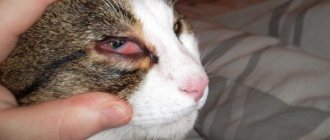Cat owners may not always understand that their pet needs urgent treatment due to hidden symptoms of the disease. These conditions include hematuria – the appearance of blood in a cat’s urine for various reasons. As a rule, this problem often goes unnoticed in time, since the animal urinates in a tray with filler, where it is almost impossible to distinguish the color of the urine. And even having noticed a brownish tint to the urine, not every owner understands the seriousness of this phenomenon. However, it is important to pay close attention to, as hematuria indicates that your cat is in need of emergency medical attention.
Signs of hematuria in a cat
“Hematuria” is literally translated from Latin as “bloody urine” (“hema” - blood, “urina” - urine). Indeed, one should be wary if even the slightest traces of blood are detected in cat urine - this cannot in any way be considered a manifestation of the norm and clearly indicates that pathological processes are occurring in the cat’s body.
How to detect blood in a cat's urine
The problem is that detecting blood in the urine in the initial stages of the disease can be very difficult - it often cannot be seen with the naked eye. Most owners notice signs of hematuria, when the problem has developed, there is a lot of blood and the urine has acquired a pronounced color:
- pink;
- scarlet;
- reddish;
- brown.
Sometimes, however, the disease manifests itself immediately and in visible signs - these can be dark red spots, clots in the urine, or even a bloody puddle in the tray. In order not to miss the moment, it is necessary to pay attention not only to obvious, but also to accompanying symptoms, and as soon as you suspect something is wrong, immediately consult a doctor.
In such situations, the animal may become lethargic, apathetic, or, conversely, show increased anxiety - rushing about and meowing plaintively before going to the toilet in a small way. Often, the cat “misses” the tray and pees in the wrong places, thereby indicating to the owner that he is not feeling well.
Video: hematuria in a cat - how and why it happens
Symptoms of hematuria
The most obvious sign of the disease is a change in urine from yellow to burgundy or scarlet. Please note that your cat may pee reddish urine after eating carrots or beets. After a couple of days, the urine will become normal.
When a cat gets sick, it becomes more lethargic and its appetite decreases. It may be painful for her to pee and she may urinate on soft surfaces or carpets. If a cat pees and vomits blood, then there is a high probability of severe food poisoning
© shutterstock
Most often, the reddish tint of urine is visible to the naked eye. You can try checking your urine yourself for the presence of blood. You will have to wait for the cat to pee in the tray, collect the urine and place the jar with it near a lamp or window. A reddish or burgundy tint, blood clots - all this is a sign of hematuria.
If you do not notice a reddish tint to the urine, but your cat is behaving unusually, you can bring the test to a veterinary laboratory.
Urine with hematuria
With hematuria, a cat urinates bright red urine, and the intensity of the color varies depending on the number of red blood cells. The more, the more pronounced the reddish tint will be. Less commonly, a cat pees with blood clots, as this is a sign of a severe stage of the disease. Blood cannot always be seen without tests; sometimes it is detected only when examined with a microscope.
Causes of blood in urine
Blood can enter the urine either directly from the kidneys or from other organs of the urinary system. Since hematuria is not an independent disease, but only an indicative symptom of a disease or injury, it is urgent to determine its causes and do everything possible to eliminate them.
Blood in the urine is most often a consequence of kidney pathology
Hematuria may have the following causes:
- kidney and urinary tract diseases;
- pathologies of the bladder;
- the presence of stones in the kidneys or bladder;
- inflammatory processes of the genitourinary system;
- various infections;
- reproductive problems;
- injuries;
- endoparasites;
- intoxication, including drug intoxication.
Falls from heights are not as safe for cats as is commonly believed - they can lead to serious injuries.
Quite often, blood in the urine appears after the cat has been injured - for example, it was hit by a car or fell from a balcony. Still, rumors about nine cat lives are greatly exaggerated, and an unsuccessful fall from a height is fraught with significant damage to the animal.
Prevention
Although pink urine can occur for a variety of reasons, there are not many methods to prevent this phenomenon. Almost all of them involve careful care of the animal.
Measures to prevent the appearance of blood in the urine of cats:
- The animal must receive the required amount of nutrients from food, so it is very important to monitor its diet and variety in the menu;
- It is necessary to take timely preventive measures against the appearance of worms and fleas, as well as get the necessary vaccinations on time;
- The risk of falling from a height, hitting or fighting should be minimized;
- Walking outside must be supervised. You should walk in a safe area;
- It is necessary to systematically check what type of urine the cat urinates and whether there is any blood in it;
- At the first signs of any disease, you should immediately take your pet to the veterinarian and begin treating it;
It is important to remember that treating a serious disease is much more difficult than preventing it in the early stages.
Symptoms of disease development
Blood in a cat’s urine can be a sign of many diseases, which can only be accurately determined at an appointment with a veterinarian. However, primary diagnosis can also be made based on careful observations of the pet - in any case, these data are very important for the doctor and will help him quickly recreate the full picture of the situation.
Table: problems that cause blood in a cat’s urine
| Possible problem | External manifestations of hematuria | Associated symptoms |
| Exacerbation of urolithiasis | The concentration of blood in the urine may vary depending on the degree of injury to the excretory organs by stones |
|
| Acute hemorrhagic cystitis | Urine turns pink or red |
|
| Injury | Copious blood in the urine, possible clots |
|
| Postpartum complications | Bloody discharge mixed with urine, sometimes severe bleeding |
|
| Poisoning, unhealthy diet | Kidney bleeding as a result of intoxication |
|
| Parasitic infestation | Blood impurities appear in the urine if parasites have settled in the bladder or renal pelvis |
|
| Tumors in the genitourinary area | Clots or spots of blood in the urine, sometimes quite large |
|
Video: urolithiasis is a common disease in cats
Hematuria, to varying degrees, can also manifest itself in systemic internal diseases not related to the genitourinary system; among them:
- heart failure;
- liver diseases;
- blood diseases.
Associated symptoms
In cases where a cat actually pees with blood, accompanying symptoms appear:
- during urination the animal screams (as a result of pain);
- nervousness appears (the cat often twitches the tip of its tail or fur along the spine, and shows aggressiveness as a result of discomfort);
- leaves marks on carpets and furniture (small puddles and wet spots appear when a cat develops urinary incontinence);
- decreased appetite or lack thereof;
- a slight increase in body temperature (the norm for healthy cats is 38-39.5 degrees);
- reducing the cat’s physical activity, choosing warm places to sleep (battery, heater).
The appearance of these signs indicates an increase in the inflammatory process in the animal’s body. In such cases, the cat requires urgent veterinary care.
Diagnostics
The effectiveness of treatment for hematuria in cats depends not only on timely access to the clinic, but also, of course, on how correctly the diagnosis was made. Therefore, it is very important to quickly apply all the necessary diagnostic methods, without refusing the tests offered to you - even the most experienced specialist will not be able to accurately determine the problem “by eye”.
Immediately upon arrival at the clinic, you must undergo a clinical examination by a veterinarian and do three mandatory tests:
- general urine analysis;
- Ultrasound;
- X-ray.
A blood test is the most important test for suspected hematuria
This is a quick and informative diagnosis, the results of which may require additional clarification:
- general blood analysis;
- blood biochemistry;
- urine reaction (pH);
- MRI;
- oncological tests.
Analyzing the research results, the veterinarian first of all tries to exclude or confirm the presence of urolithiasis, since in the vast majority of cases, manifestations of hematuria indicate precisely this disease. Diagnosis must be as prompt as possible; loss of time in many such situations can result in death for the animal.
Care
Treatment for urine leakage will depend on the underlying or related medical conditions that are the underlying cause of the condition. A urinary tract infection may be associated with another urinary tract disease, such as cancer or urinary tract stones (urolithiasis). Or hematuria may be caused by a condition that affects the body as a whole, such as overproduction of steroids by the adrenal glands or diabetes. The systemic generalized condition must be treated before the hematuria can be resolved.
Surgery may be indicated for urinary tract stones, neoplasms, and urinary tract injuries. A blood transfusion may be needed if your cat has very low red blood cell counts. Fluids will be used to treat dehydration, and antibiotics may be used to treat urinary tract infections and general illnesses caused by bacteria in the blood (bacteremia). Urolithiasis and kidney failure may require dietary changes to prevent recurrence.
If your cat has a bleeding disorder, the blood thinner heparin can be used to control it.
How to collect urine for analysis
Before visiting the clinic, if possible, you should collect urine in a sterile jar for analysis. Of course, this procedure can also be done by a veterinarian using a catheter or a sterile syringe (cystocentesis), but such methods are quite traumatic, have a number of side effects and are used in emergency cases when the cat does not pass urine at all. In all other situations, urine can be collected at home.
Urine collection through a catheter is done in the clinic, but this method is traumatic and fraught with infection
Methods and rules for collecting material
To speed up the identification of the causes of illness, you need to independently prepare biomaterial for analysis. It is unlikely that you will be able to persuade your cat to pee directly into a clean jar - although some owners can even do this. Owners, taking into account the habits and character of their pets, use various methods of collecting urine:
- from the toilet, sink or bathtub - if the cat is used to peeing there;
- using a children's urine collector - this device is freely sold in pharmacies;
- from the cat litter box - the most common and reliable method.
To collect urine from the toilet or sink, they are covered with plastic bags or covered with film.
We can recommend that most owners use a regular cat litter box - a plastic tray - as an improvised urinal. This is convenient, reliable and not at all difficult to do if you follow the recommendations of the step-by-step instructions:
- If possible, buy a new tray for collecting biomaterial - even a well-washed old cat litter box can retain residual salts and microorganisms on the walls, which will affect the accuracy of the analysis results.
- Thoroughly wash and dry the tray and the inner grid, assemble the structure and place it in a place familiar to the animal.
- Try to calm your pet and gently massage his bladder area if this does not cause severe pain.
- Such preliminary actions will be enough if your cat is accustomed to pee on an empty tray - all you have to do is collect the urine.
- If the animal refuses to go potty without litter, use one of the options for urine collection kits - they can be purchased at veterinary pharmacies, pet stores or online.
- Sprinkle the filler from the kit in the tray as usual, and when the cat pees, carefully collect the urine - for this, the kit has a special pipette, but you can also use a regular syringe.
- It is important to maintain maximum cleanliness when collecting urine so that unnecessary chemical and biological “additives” do not get into it - thoroughly wash your hands and all the equipment that you will use.
- It is advisable to put the collected urine (in a test tube, syringe or special container) in the refrigerator and deliver it to the veterinary clinic as soon as possible - no more than five hours should pass between the time of collection of the biomaterial and the analysis.
The cat litter box is convenient to use for collecting biomaterial
“Craftsmen” sometimes replace plastic granules with finely chopped cocktail straws or oven-roasted corn kernels - according to reviews, this also works well.
Video: collecting cat urine for analysis
New products from the pet industry for monitoring urine parameters
In veterinary pharmacies, pet stores and via the Internet, you can now purchase many devices and consumables that help you easily collect cat urine for analysis, as well as independently monitor the condition of a cat that has already been diagnosed - for example, urolithiasis. Owners of sick animals are well aware of how important this is, but many of them are not even aware of the existence of such useful and convenient new products.
Table: products for the convenience of collecting urine and monitoring its composition
| Product Name | Purpose | What is | Approximate price |
| Kit for collecting urine from cats “Talismed” (Russia) | Kit for collecting and transporting cat urine |
| 215 rubles |
| Urine collection kit for cats Kruuse KIT4CAT (Denmark) | Kit for collecting and transporting cat urine |
| 1100 rubles |
| Diagnostic tray filler Aromaticat | Tray filler that changes color depending on urine pH | pH indicators are silica gel filler granules | 320 rubles for a 3-liter package |
| Diagnostic tray filler PrettyCat | Rapid cat urine pH test | PrettyCat is poured into the tray on top of any litter, and within a minute of use its granules change color | 180 rubles per 110 gram jar |
| "Uripolian-11A" | Express study of 11 indicators of the composition of cat urine | Test strips that are dipped into fresh urine and quickly display data on the main indicators of analysis | 750 rubles per package for 50 tests |
Urine collection kits, which have already become popular with many owners, make it possible to easily provide biomaterial for analysis to the clinic. They use non-absorbent fillers: hydrophobic sand or plastic granules. One set is enough for several studies.
Do not try to wash plastic granules in order to reuse them, as some overly zealous owners do - this will inevitably distort the analysis results. Pipettes and test tubes are also disposable, but they can be replaced with a sterile syringe, through the needle of which urine is easily collected and then brought directly to the clinic in the syringe.
Important: plastic granules are used only once and then discarded
Diagnostic fillers and express strips are very convenient for independent testing. But they are more often used not in emergency cases, but to monitor the condition of an animal with an already identified chronic disease. It is impossible to make a diagnosis on your own, relying only on their testimony - this must be done by a doctor, especially in case of hematuria.
Photo gallery: devices for collecting urine and monitoring its composition
Aromaticat diagnostic tray filler changes color from orange (normal) to blue (critical)
A urine collection kit with plastic granules is a convenient and relatively inexpensive device
A urine collection kit with hydrophobic sand is not cheap, but is well accepted by cats. Uripolian test strips are produced to study the most important indicators of the composition of urine. PrettyCat diagnostic litter for the tray is used together with any regular litter
Video: making it easy for yourself
What to do if blood appears in the urine: treatment at home
In severe situations, when bleeding threatens life, or calculi (stones) clog the lumen of the excretory canals and block the outflow of urine, surgery is performed in the clinic. In most cases, the animal owner takes part in treating the pet at home, following the orders of the veterinarian.
The therapeutic strategy is based on diet therapy and drug treatment.
Diet therapy
If a cat pees in blood, then proper nutrition cannot be avoided for the following reasons:
- It is necessary to maintain average fatness. Cats that do not walk outside, especially sterilized ones, are prone to overeating with reduced physical activity. Boredom causes them to develop an appetite. In obese pets, metabolism slows down, fat puts pressure on the urinary organs, urine stagnates, which contributes to the attachment of microbes to the wall of the bladder, as well as the precipitation of urinary salts.
- Economy class feeds and natural products are unbalanced in protein. They have a low concentration of energy, little dietary fiber and vitamins. A significant part of the defective protein is not digested and is converted into uric acid. Nitrogenous slag is poorly soluble in water, is prone to precipitation and is a breeding ground for microbes.
- In animals predisposed to urolithiasis, 2 types of stones form. Phosphorus-rich struvite forms in alkaline urine. In acidic urine, oxalates—calcium salts and oxalic acid—precipitate. The veterinarian conducts a urine test, makes a diagnosis, based on which he recommends the use of specialized medicinal food.
Be sure to read:
A cat is vomiting hair: reasons, what to do, medications and folk remedies, prevention
Depending on the presence of stones and the patient’s condition, the following veterinary feeds are used:
- Purina UR for urolithiasis;
- Hill's Metabolic + Urinary for weight loss and struvite dissolution;
- Eukanuba Urinari Oxalate;
- Eukanuba Urinari Struvite;
- Royal Canin Neutered Adult Maintenance for the prevention of urolithiasis and obesity in sterilized cats.
Medicines and folk remedies
Veterinarians prescribe complex remedies. The drug Stop-cystitis in tablets or suspension contains the antibiotic nitroxoline and the antispasmodic drotaverine, which inhibit pathogenic microflora, relieve spasms and relieve pain.
Most of the drugs popular in the treatment of diseases of the urinary canal, kidneys and bladder are produced on the basis of traditional medicine and are a mixture of extracts of medicinal herbs.
The following herbal remedies are popular:
- Stop Cystitis Bio;
- Erwin the cat;
- Phytodoc Nefrospas;
- Urolex;
- Urinari tract support.
How to help your cat yourself
The difficulty of emergency home care is that it is highly undesirable to give your pet any medications before taking tests. Under their influence, the clinical picture may become blurred, and making a correct diagnosis will be difficult. But if it is not possible to urgently take your pet to the clinic, you should still try to alleviate his condition.
If you want to help a sick pet, take him to the clinic
What every owner can do in order not to harm, but at least somehow help the animal:
- provide peace to the sick pet by placing it in a warm, draft-free room on a bedding surface;
- intramuscularly administer pain-relieving antispasmodic drugs (No-shpa, Baralgin), which will relieve pain;
- exclude all solid foods from the diet, instead offer liquid food, easily digestible food, water - without restrictions;
- to disinfect the urinary tract before going to the doctor, give the cat decoctions of bearberry, parsley root, furadonin;
- Inflammatory products are removed from the urinary tract using a decoction of juniper and horsetail.
But even herbal decoctions can become unsafe until an accurate diagnosis is established. The main thing that an owner can do for a sick pet is to take it to the clinic as soon as possible. A personal examination by a doctor cannot be replaced in such a situation by consultations with him by phone, and even more so by advice from friends like “my cat had this too.” Don't waste time - it's pointless and dangerous.
First aid for detecting blood in a cat's secretions
What to do in a situation where it is not possible to immediately show the animal to a veterinarian? The answer is simple: do not self-medicate. It is advisable to try to contact the doctor by telephone to receive detailed recommendations and, if necessary, prescribe a pain reliever. You also need to take actions that will help alleviate your pet’s condition.
First aid for hematuria:
- Provide the cat with peace by placing it in a dry, clean room;
- Provide access to clean water for drinking;
- Feed the animal liquid food;
- Give your cat a decoction of bearberry or parsley, which has disinfectant properties;
- Decoctions of juniper and horsetail will help reduce inflammation of the urinary tract.
It is unacceptable to treat an animal with antibiotics without a doctor's prescription. It is important to collect tests as early as possible and show the cat to a specialist.
Medical assistance
Be prepared for the fact that you may need not only conservative treatment, but also surgery - otherwise you will lose your pet. Urgent surgery is necessary if there are large kidney stones or serious injuries with organ damage and internal bleeding. Surgery followed by chemotherapy may also be recommended for cancer problems.
In a critical situation, only surgery can save the cat's life
In other cases, complex drug therapy is prescribed:
- hemostatic agents;
- antibiotics;
- anti-inflammatory drugs;
- antispasmodics.
Dosages of medications, regimens and duration of treatment can only be determined by a doctor depending on the diagnosis, condition and individual characteristics of the animal. Self-medication for hematuria is strictly unacceptable. It can lead to dangerous complications and negative side effects from poorly chosen drugs.
Treatment
Treatment of cats is carried out only after diagnosis and depends on the identified pathology:
- For bacterial infections, antibiotics (in injections and tablets) with hemostatic drugs are prescribed.
- For urolithiasis - a long course of nutritional therapy and symptomatic therapy (hemostatic and antimicrobial drugs, medications to destroy crystals).
- If a cat has large stones, surgical removal is required.
- If a tumor is found, then after determining its malignancy, surgery and subsequent chemotherapy are prescribed.
- If the urinary ducts are obstructed (blockage with stones), a catheter is inserted and the bladder is washed.
- Parasitic diseases (dirofilariasis) must be treated for a long time (about 1 year) using drugs based on moxidectin.
- Injured cats are treated as inpatients; the choice of medications is determined based on the severity of the patient’s condition.
- Castrated cats with urolithiasis and hematuria are often prescribed urethrostomy - a surgical operation to create a new enlarged urethral opening, this allows the animal to pee painlessly.
If the owner notices blood in the cat’s urine, but there is no opportunity to visit a veterinarian in the near future, you need to provide first aid yourself.
What to do:
- ensure that the cat stays warm and does not let it go outside;
- make sure there is warm water in the drinking bowl;
- feed soft food or pates;
- drink a decoction of horsetail, bearberry, woolly erva (will relieve inflammation) or buy ready-made “KotErwin”;
- if urination is severely painful, you can give your cat 1 tablet of Furagin (as a result, the urine will turn a rich yellow or orange color).
This treatment can slightly improve the pet’s condition and relieve pain for a while.
When to urgently contact a veterinarian
You should contact your veterinarian if there is blood in your cat's urine.
Reasons to contact a veterinarian for emergency reasons:
- combination of hematuria with manifestations of acute blood loss: pallor of the cat’s mucous membranes, general depression, weakness, rapid and shallow breathing, increased heart rate;
- acute urinary retention, which occurs against the background of previous hematuria, can be caused by tamponade of the bladder with blood clots or blockage of the lumen of the urethra by a urinary calculus;
- combination of hematuria with fever;
- suspicion of poisoning with anticoagulants;
- in the presence of severe pain;
- for injuries.
Video: urolithiasis in cats
What diagnostic methods do specialists use?
The doctor asks the owner about the onset and manifestations of the disease in the cat, clarifies the conditions of its feeding and maintenance; then examines the cat. To clarify the diagnosis, modern veterinary medicine has a whole arsenal of additional diagnostic methods:
- general blood test - assesses the severity of anemia, as well as inflammatory changes;
- general urinalysis - assesses the degree of hematuria, the presence of protein and leukocytes in the urine; the presence of other components (mucus, bacteria, salt crystals);
- biochemical blood test - collection of information about the functional state of internal organs, kidney function is assessed by the content of urea and creatinine;
- bacteriological culture of urine to determine the sensitivity of the flora to antibacterial therapy in the inflammatory nature of the disease;
- coagulogram - if a blood clotting disorder is suspected;
- Ultrasound of the abdominal cavity and retroperitoneal space - allows you to assess changes in the shape, structure and location of the kidneys and urinary tract, the use of Doppler ultrasound - examines the vessels of the kidneys and the blood flow in them;
- endoscopic examination, carried out under anesthesia, the mucous membrane of the bladder and the orifices of the ureters are examined using an endoscope;
- computed tomography - may be performed to clarify the diagnosis in some cases;
- X-ray methods - are now used less frequently, since the ultrasound method is safer and more informative; radiography is used for injuries, suspected presence of stones (but not all stones are visualized in this way); The use of contrast expands the information content of the method.
Video: diagnostic cystoscopy for hematuria in a cat
How to properly collect urine
The cat's morning urine is collected and delivered to the laboratory within the next 3–4 hours:
- You need to remove the litter from the cat's tray and wash the tray itself thoroughly.
- After the cat has visited the litter box, the urine from it is transferred to a plastic container with a lid, which can be purchased at a regular or veterinary pharmacy.
- It is convenient to use a disposable syringe to collect urine from the tray.
It is also possible to collect urine for analysis using bladder catheterization - in a veterinary clinic.











